Coronavirus (COVID-19) support study experiences of and compliance with self-isolation: main report
This research explores compliance with and experiences of the 10 day period of self-isolation undertaken by index cases, contact cases, and international travellers during the COVID-19 pandemic. The research took place between March and June 2021.
This document is part of a collection
6. Testing
6.1 Background
While developments such as the mass vaccination programme have been introduced and offer hope for the future, testing remains crucial as Scotland continues to navigate the COVID-19 pandemic. It has been estimated that around one in three people with COVID-19 are asymptomatic, meaning that they have the potential to pass the virus on to others but may not experience symptoms themselves[55]. From the 26th April 2021, lateral flow tests have been available free of charge for use at home by anyone, irrespective of whether they have symptoms or not. As well as the identification of potentially asymptomatic cases (a positive result is confirmed by a subsequent PCR test), reduced transmission of the virus and the prevention of localised outbreaks as a result of self-isolation[56] such tests have been used prior to travel to Scotland's islands, reducing the potential for case levels to be impacted by those travelling from areas with higher case numbers[57].
The purpose of including information on testing within this study was not only to understand the reasons that motivated participants' most recent tests and their results[58] but also whether test results while in self-isolation had an influence on levels of self-isolation compliance, experiences of testing and what impact changes introduced over the fieldwork period, such as the introduction of lateral flow tests, may have had on testing locations and/or waiting times for test results.
6.2 Testing and Index and Contact Cases
6.2.1 How often are individuals being tested and does this differ between Index and Contact cases?
Survey participants were asked how many times, to-date, they had been tested for COVID-19. Nearly all (98%) Index and Contact Case participants had been tested at least once. Contact Case particpants were more likely than Index Cases to have been tested multiple times: 62% of Contact Case participants had been tested at least twice, compared with 54% of Index Case participants. [Figure 6.1, Table 6.1]
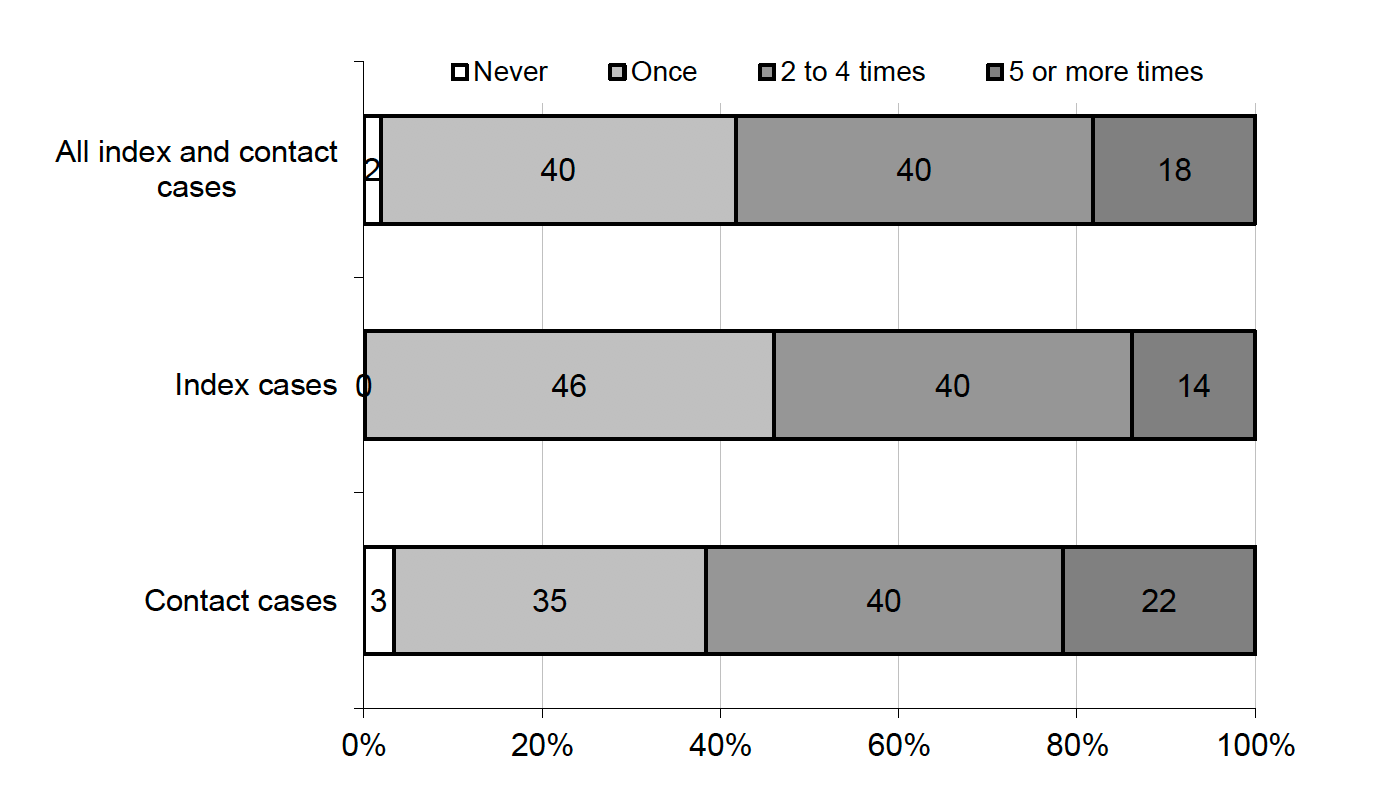
6.2.2 What was the reason for the most recent test undertaken by Index and Contact Case participants?
As Figure 6.2 shows a quarter (25%) of Index and Contact Case participants said they were experiencing symptoms when they got their most recent test with nearly half (47%) of Index Cases responding that this was the case (and 7% of Contact Cases). Two-thirds (69%) of Index and Contact Case participants said they got tested because they had come into contact with someone who tested positive: 56% said they had come into contact and were asked to get tested by Test and Protect, and 22% said they had come into contact with a positive case and chose to get tested.[59] [Figure 6.2]
Between waves, the proportion of all Index and Contact Case participants that had been tested as a result of experiencing symptoms decreased from 31% in wave one to 20% in wave three, while the proportion tested as a close contact after contact from Test and Protect rose over the same period from 49% to 61%. [Table 6.2]
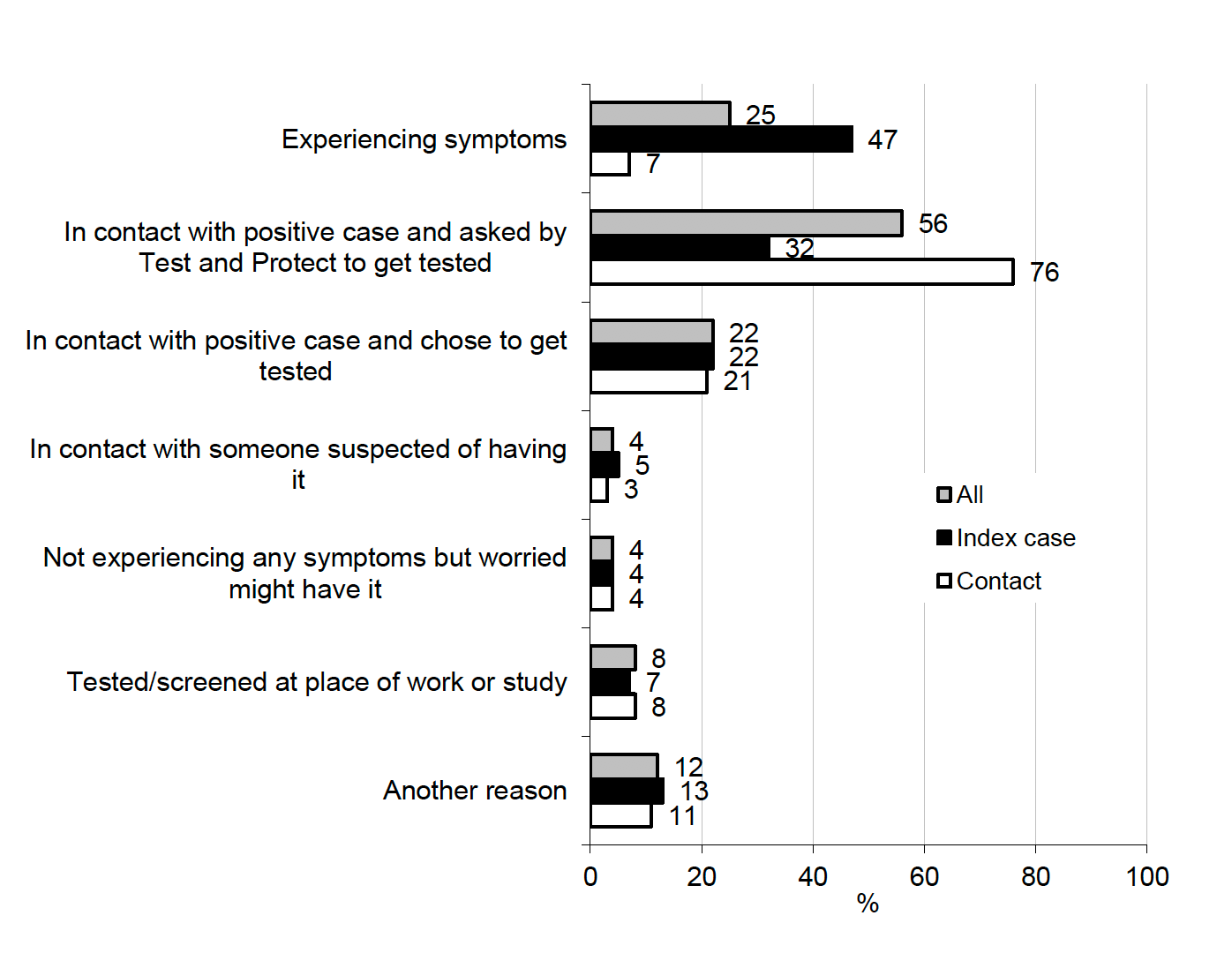
6.3.3 Where are tests taking place and has this changed over time for Index and Contact Case participants?
Index and Contact Case participants were asked to select, from a list, where their most recent test took place. A local drive-through or walk-in testing site was the most common location for obtaining a test, used by 67% of all Index and Contact Cases. A further 19% took their test at home, using an NHS home testing kit. Smaller numbers used a mobile testing unit (5%), a rapid testing site (2%), NHS premises (2%), a care home or social care setting (1%), their workplace (1%) or somewhere else (2%). Home testing kits were most commonly used by those living in the Scotland's more deprived areas. [Figure 6.3, Table 6.3]
Changes in the location of participants' most recent tests were recorded across the waves with a decrease in the proportion that took place at a local walk in/drive through testing site (73% in wave 1 to 64% in wave three) and an increase in testing at home (from 15% to 23% over the same period). [Table 6.3]
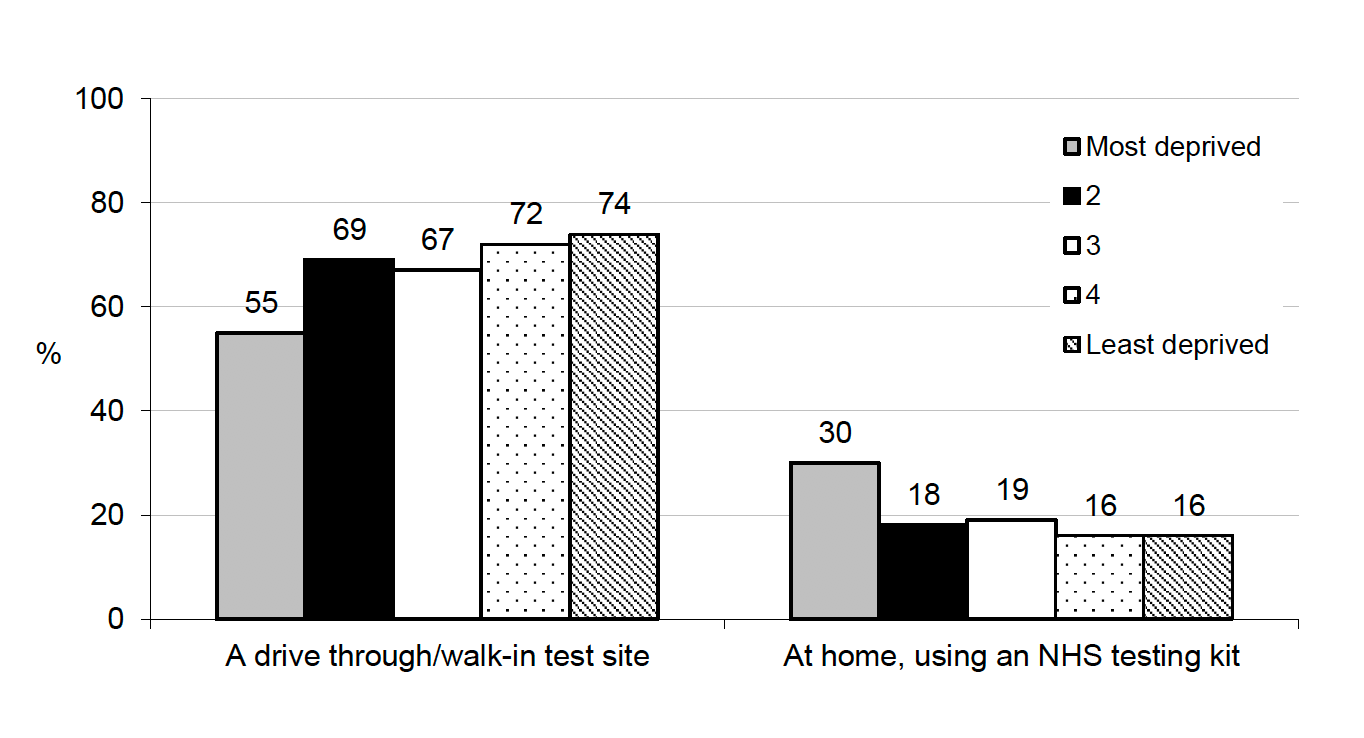
Qualitative interview participants had taken COVID-19 tests at a range of locations including: going to drive-in test centres, walk-in centres and having the test posted to their homes. Participants had mainly positive experiences of COVID-19 testing and testing centres; they found the testing process, regardless of the format, easy, straightforward and efficient on the whole. In situations where the test was posted to people's homes, it was commented that the instructions were clear and easy to understand. That said, there were interview participants who commented that they knew of close family members who had been too unwell to access COVID-19 test centres, though when finally tested it confirmed that they had an active COVID infection.
"I thought it [home testing] was okay, yes. It's a little bit uncomfortable for anyone who's done it really, but I thought the instructions were quite clear. I can remember there being a video as well. It might have been a third-party video, but there was a video I found online that talks you through it step-by-step. That certainly helped. Especially I think sometimes you can look at a booklet and think one of two things, but with a video or some sort of content to follow, it made it a little bit easier." (Contact Case)
"It [drive-in test centre] was really straightforward. They have people at every point that you stop at in the test centre, drive through bit, to guide you. I wasn't keen on doing this, I just hate stuff like that, if that makes sense - but you do it yourself where we are, so they just give you the kit. I know in some places they do it for you but you just do it yourself, but there was somebody next to the car the whole time if I needed them. It was pretty straightforward." (Household Contact Case)
6.3.4 How long are Index and Contact Case participants waiting for their test results and has this differed by where it was undertaken and/or over time?
Index and Contact Case participants that had been tested for COVID-19 were asked how long they waited for their most recent test result. Two-thirds (70%) of Index and Contact Cases received their most recent test results within a day, including 9% within an hour. Of those using a local drive-through or walk-in testing site, three-quarters (76%) received their results within a day. For those using a home-testing kit, half (51%) received their results that quickly. The proportion of all Index and Contact Case participants who received their most recent result within an hour rose from 5% in wave one to 12% in wave 3, potentially reflecting the increased availability of in-home lateral flow tests. [Figure 6.4, Table 6.4]
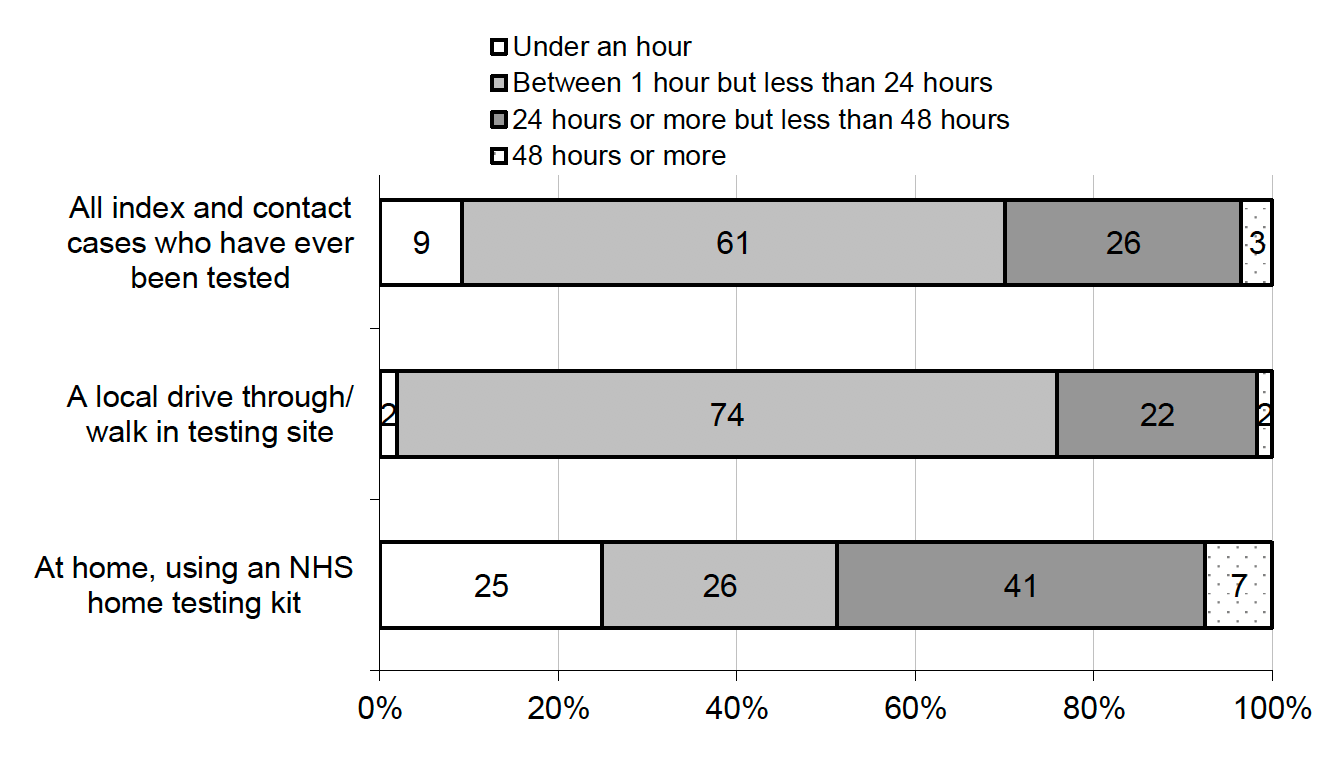
6.2.2 Result of last test and levels of compliance among Index and Contact Case participants
Of Index Cases, 95% reported a positive result, while only 4% of Contact Cases reported this. [Table 6.5] Index and Contact Case participants who tested positive on their most recent test were more likely to comply fully with self-isolation than those who tested negative (80% of those who tested positive complied fully, compared with 75% of those who tested negative). In both groups, nearly all of those who did not comply fully showed at least partial compliance with the rules. [Figure 6.5, Table 6.6]
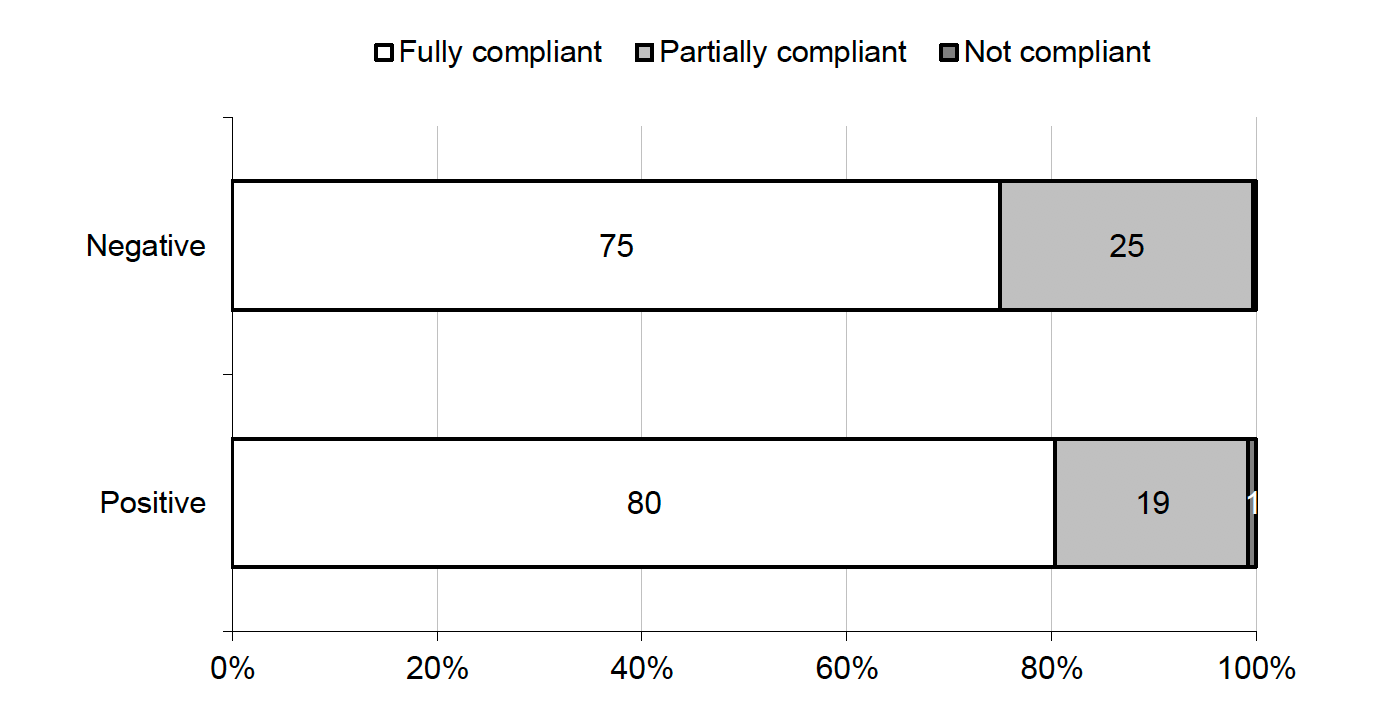
6.3 Testing and International Travellers
As testing was a requirement of international travel and response on location of testing varied accordingly, the findings for reason and location of last test are not explored here. Only a small number of International Traveller participants had tested positive on their most recent test, therefore, findings by test result are not presented for these participants.
6.3.1 How often have International Travellers been tested?
International Travellers were more likely to have been tested multiple times (including potentially for other reasons prior to their international travel) than Index and Contact Case participants. The vast majority of International Traveller participants (95%) had been tested more than once, which is not surprising given that testing was a requirement for all International Travellers. More than half (54%) had been tested five times or more. This number of tests was more common among those who booked managed isolation (quarantine) packages (60%) than those who booked test kits for self-isolation (52%). [Table 6.8]
6.3.2 How long are International Travellers waiting for their test results?
A quarter of International Travellers (23%) received their results within a day of the test. Those who were self-isolating at home were more likely to wait longer: 83% waited more than 24 hours, compared with 49% of those who booked a managed isolation (quarantine) package. The results for International Traveller participants isolating at home tended to take longer than tests undertaken at home by Index and Contact Cases. [Table 6.9]
6.3.3 What have been the outcomes of the most recent test taken by those self-isolating as a result of international travel?
The vast majority of International Travellers received negative results from their most recent tests: 95% reported a negative test result, with 5% still awaiting a result. Less than 0.5% received a positive result. Those who booked managed isolation (quarantine) packages were more likely to test positive (2%) than those self-isolating at home (less than 0.5%). [Table 6.10]
Contact
Email: socialresearch@gov.scot
There is a problem
Thanks for your feedback